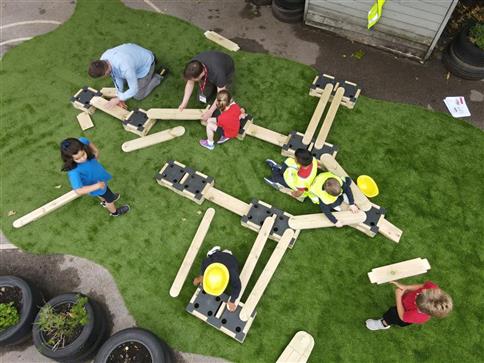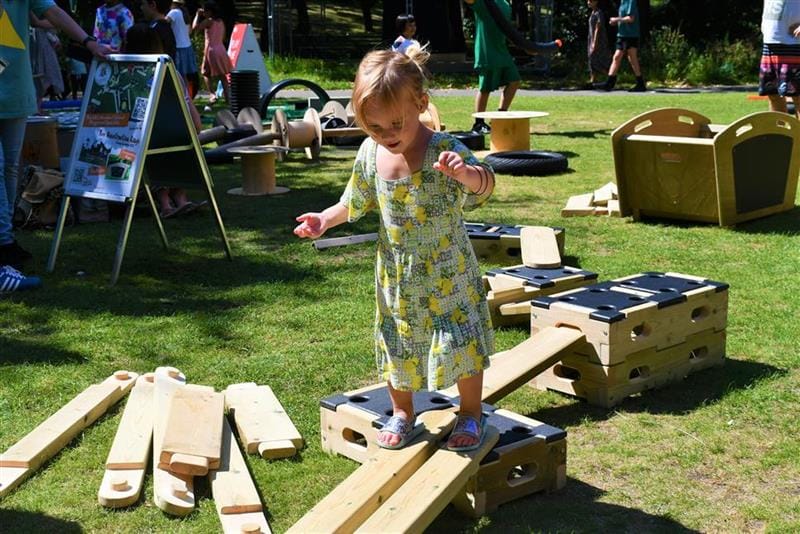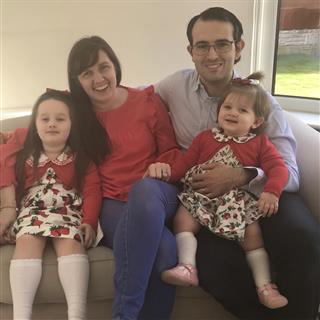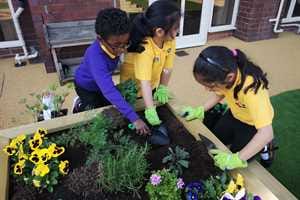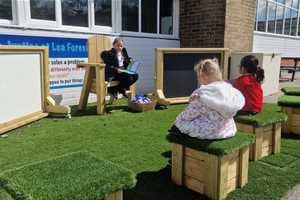
Outdoor Learning and Play
The 6 Stages of Block Play and Why They Really Matter!
Building blocks are a completely open-ended resource that create a world of possibilities for children. Pupils can work independently or with others when making their creations, allowing their imaginative ideas to flow. Communication is strengthened when children play with blocks as they learn to express their ideas and talk about what they have created. Problems can be solved as children determine which block will fit or how a structure will remain stable. Pupils develop resilience and solutions through trial-and-error approaches and hands-on learning.
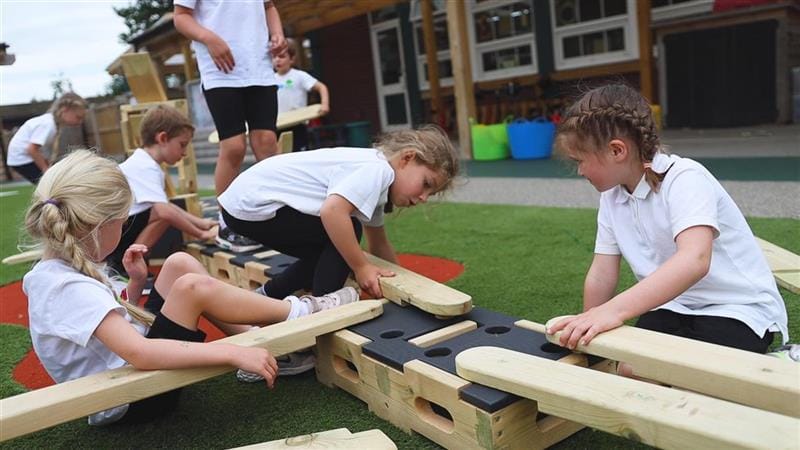
Friedrich Froebel who founded Kindergarten Education and innovative teacher Caroline Pratt, who believed in allowing children to work together to reconstruct their experiences through play, both championed for pupils to use physical objects for meaningful play.
Building blocks are a worthwhile investment for a nursery or school setting. Children begin to play with blocks as they start their learning journey as young babies, progressing to toddlers and beyond. When engaging with blocks children move through several stages of play and development.
Exploring and Carrying Blocks
At first young children will explore blocks as objects without building. They will usually hold them, shake them, taste them and even throw them as they explore all of the tactile properties blocks have to offer. They may hold a block in each hand and hit them together or knock down a structure built by somebody else, exploring sounds and sensations.
.jpg)
Infants and toddlers will begin to carry blocks around, perhaps transporting them using bags and toy vehicles. Blocks will be collected and can be sorted by colour or shape.
Stacking
Toddlers begin to make vertical and horizontal rows with blocks and they will enjoy repeating this process.
Blocks will be stacked on top of each other to make a tower until they fall, providing young children with an understanding of cause and effect. When children have mastered building rows and towers, they may progress to multiple rows to resemble walls and floors.
Making Bridges
Simple bridges can now be made by placing two blocks side by side with a space in between them, with a third block placed on top. Children need to consider size and length of their towers/blocks but once this skill is mastered pupils can build bridges on top of bridges and will enjoy transporting objects and themselves across bridges.
Enclosures
In this stage, children are able to make a closed circuit with blocks. They will need to understand how to turn and place blocks for this to happen and may begin by making a square-shaped enclosure which can be added to by connecting many squares. Once mastered, children will experiment with the size and shape of their enclosures, choosing to make them for themselves or their toys.
Patterns
Structures are now built that include symmetry, patterns and balance. Models become more complex as children express their creativity. Towers, rows, bridges, enclosures and decorative patterns may be evident in a single build.
Constructing and Naming
Pupils have a plan before they build and blocks may be used to aid play. A build may take on a name, have a particular purpose or resemble a known structure. Familiar features such as doors, windows or wheels may be present and pupils can add their own props/loose parts to support role play and aid understanding.
.jpg)
In order to progress through these stages, children need to be given plenty of opportunities to play with blocks. Natural progression through these stages will occur if children have open access to blocks and time to explore them.
If readily available, children can use blocks to create whatever they need to enhance their play. Blocks are an essential classroom tool for encouraging independent, imaginative play as well as developing important gross and fine motor skills. When playing with blocks, pupils find out for themselves how things work and practitioners can help to extend progress.
Product Spotlight
Invest in a Pentagon Play Builder or Play Blocks Set
Play blocks must be hardwearing and stand up well to extended use by young children. It is beneficial to have different types of construction equipment to provide children with choices when playing. There should be plenty of bricks and components so that children are not frustrated when bringing their ideas to fruition.
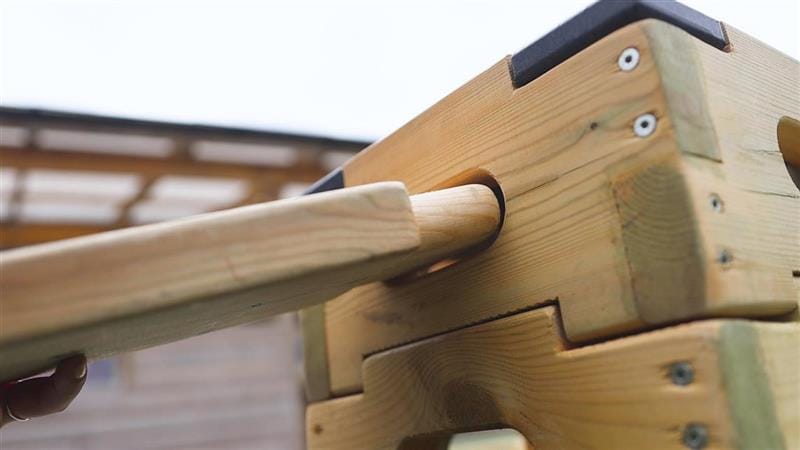
A spacious environment where pupils can spread out and build sizeable objects such as castles, rockets and cars allows children to build comfortably in groups. An outdoor space is ideal for building, allowing plenty of freedom for movement.
Construction toys are best kept in their own storage box or container, with clear, labels. Pentagon’s Construction Skips allow children to select their own block pieces and put them away safely afterwards.
Useful Prompts for Block Play in EYFS
Block Play can form an essential part of the EYFS Areas of Learning and Development. The following prompts show how communication and language skills, physical development and social skills can be enhanced through the use of block play.
Let’s Go on a Bear Hunt
Using the text ‘We’re Going on a Bear Hunt’ by Michael Rosen and a Pentagon Play Builder Set children can be asked to build a pathway to take them safely through the long wavy grass, thick oozy mud and so on. Using tenon planks to formulate their own design, pupils can construct a sizeable pathway to walk along, imagining each area that they walk through.
.jpg)
Pupils may use toys and prompts to create some obstacles that must be avoided or they may create smaller pathways using blocks in the sand pit for toy characters to journey over.
Children will enjoy joining in with the recognisable text as they journey along their pathway, creating sound effects with their voices, bodies or instruments for the squelchy mud and the swirling snowstorm. Simple maps of the outdoor area and the route the children decide to take can be constructed, perhaps drawn in chalk on the side of a Construction Skip for easy editing.
Tallest Tower
Encourage children to play freely with the building blocks and then to build towers and knock them over. Ask pupils if they can make a short tower and then a tall one. Can they work together to build the tallest tower possible, perhaps as tall as one of the children in their group? Pupils will begin to estimate and predict e.g. How many more blocks do I need?
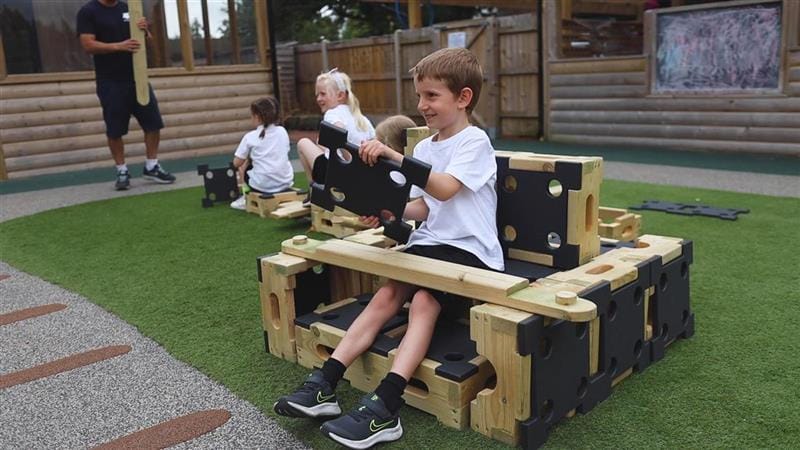
Ask pupils to find something that is shorter/taller than their tower. Can they estimate how many bricks are in their tower and then count them, developing one-to-one correspondence?
After carrying out this type of mathematics learning through play, pupils can then order a set of objects/toys from shortest to tallest and perhaps do some non-standard measuring using blocks to measure with.
Board the Bus!
Using a Pentagon Play Builder Set suggests that pupils build a bus that they can sit in. Invite the children to board the bus, stating where they want to go, with one child acting in the role of the bus driver. Pupils can pay a specific payment for their fare and they may like to sing songs together such as ‘The Wheels on the Bus’ once onboard.
Children can take turns driving the bus and a box of costumes will help them to recall their own experiences. Pupils will learn how to share equipment as they play freely, talking about where they would like to journey to and what would happen if they missed the bus!
Building a Zoo
Encourage children to make different types of pens, using their wooden blocks. Sort a set of toy animals into different groups and consider what specific animals will need to live happily.
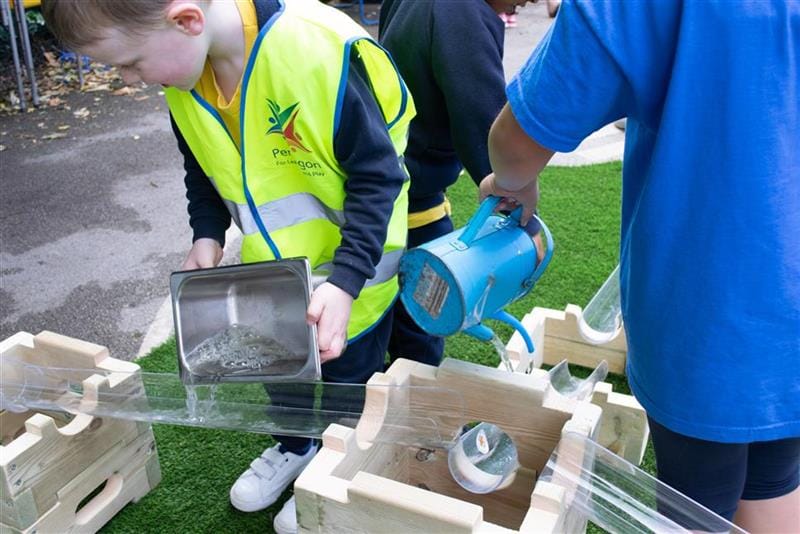
Pupils may use art and crafts materials to design food storage or shelter for the animals. Through play, children can talk about where to put each animal and why some animals need to be kept apart. Pupils can share their ideas about what each animal may eat and how their pens may differ.
Conquer the Obstacle Course
Show children the components of the Pentagon Play Builder Set and ask for their ideas about how they could travel on, under or over the blocks. Could they conquer the obstacles by crawling, jumping, running, climbing or balancing? Working as a group with adult support, ideas could be drafted onto a Play Panel and pieces could be arranged according to the plan.
Once pupils have used the course, they could talk about the bit they liked the best, what they would change or how certain sections could be made higher/more challenging.
Alternatively, pupils could design an obstacle course where they have to program a Bee-Bot to travel around or steer a remote-controlled car. Children will be able to practise using directional language as they devise a series of sequences.
Wrap the Presents!
After reading the text ‘Dear Santa’ by Rod Campbell talk about the different shaped packages containing presents. Show children how to wrap one of their building blocks to look like a present, adding ribbon and a named label.
This activity can be available for children to access throughout the day where learners can select different types of wrapping paper/tissue, bubble wrap, newspaper, scissors, string, gummed paper and sticky tape from a dispenser. This is a great activity for children working in the ‘Containing and Enveloping’ schema which supports physical development as children develop fine motor skills by working small hand muscles.
Physical Development
Wooden blocks are a superb resource, allowing children to lift, transport, place, push and construct. Playing outdoors enables pupils to work with larger, heavier pieces giving more space to interact with the landscape and each other. Through block play pupils can develop an awareness of space and will begin to understand safety rules when making a tall tower for example.
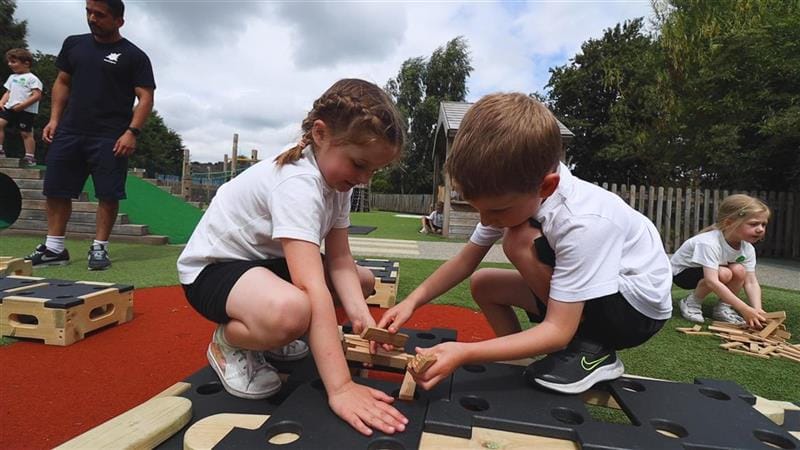
Blocks help to maximise physical development as children are given opportunities to move and build. Tidying up after play, when taking blocks down and placing them away are also important actions for developing gross motor skills and embedding control and routine.
Social Skills
Block play is vital for the development of social skills as children work together or alongside each other. Pupils learn to build relationships as they share, take turns and learn to compromise. When working together, pupils collaborate towards a common goal, signs of initiative, responsibility and leadership can be shown as children take on different responsibilities within the group.
Self-esteem and confidence can be boosted when children have taken risks and are successful in their builds. They are often eager to show off their finished model! For some children block play can be a therapeutic experience, allowing them to explore their emotions as they engage in repetitive actions.
Speaking and Listening
When you observe children playing with blocks, they often narrate what they are doing or discuss the details of their build with friends. Playing with blocks encourages dramatic play where children create their own stories and experiment with new vocabulary. Pupils describe the properties of blocks or the parts of the model they are making such as drawbridge, moat, and turret.
Increased confidence can be displayed as pupils speak about their finished model to peers or an adult. They will be able to talk about what they have made and how they did it.
Children can demonstrate their ability to listen and follow instructions during block play. They may be able to follow a sequence of instructions to achieve the desired outcome.
.jpg)
Building blocks have the power to unleash creativity in our pupils. Children will learn to reason and problem-solve to stop the bridge from collapsing or when adding an extension to their farm. Building requires logical thinking, enhances STEAM philosophy and helps to create future engineers.
“The creation of something new is not accomplished by the intellect, but by the PLAY instinct arising from inner necessity. The creative mind plays with the object it loves.” Carl Jung.
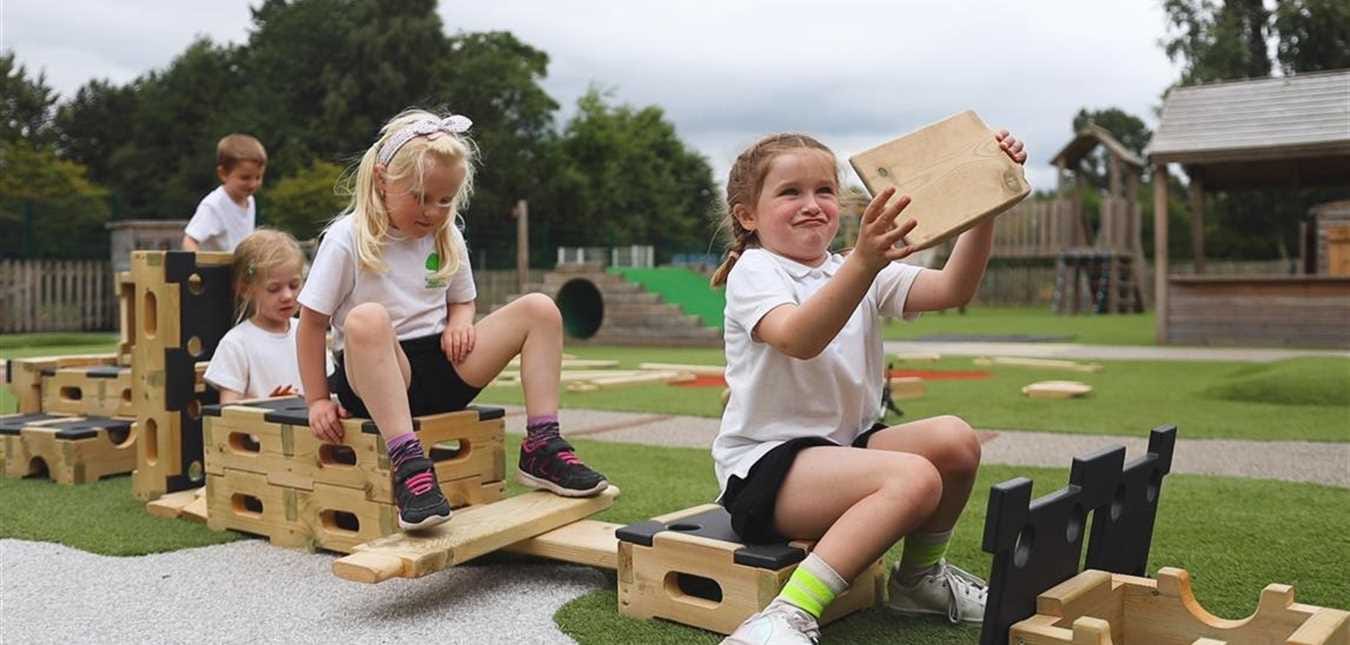
.jpg)
